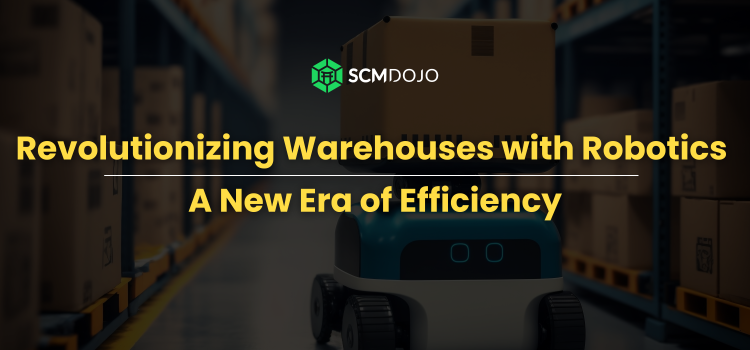The Rise of Warehouse Robotics: Revolution or Evolution?
Nowadays, logistics landscapes and supply chain management are witnessing a breakthrough innovation: the automation of robots in warehouse operations. Amazon defies mere novelty, as proven by the sterling application of over 200k mobile robot units across all their fulfillment centers worldwide. These self-contained devices, which are tactically nicknamed “Kiva robots,” have created a new lookout for traditional techniques for the storage, retrieval, and replenishment of items with unparalleled efficiency and flexibility.
Warehouse robotics adoption will be a big step, the magnitude of which could be great enough to remake the entire industry in one way or another. The natural traits of robotic systems, such as precision without error, inexhaustible diligence, and repetitiveness without fatigue, make them the best candidates for the high-pressure warehousing of today. Thanks to their capability to orient themselves in complicated environments and move complex payloads, automated lift trucks have an undisputed competitive value in the warehousing market.
But it is not just a technical revolution that arises with the increasing application of robotics in warehouses; it is also a basis for deeper reflection on desirable human job prospects and the roles of robots and humans in future productivity. With robotic systems playing more and more critical roles, alarm is raised over job losses, and the incremental necessity for reskilling is being realized in order to synchronize with the rapidly transforming landscape of work. On the other hand, other enthusiasts of the subject believe that the introduction of robotics in production facilities will be a springboard for the development of new job opportunities, enhancing human capabilities, and creating a symbiosis between technology and the workforce.
The Premise of Warehouse Robotics
The integration of robotics into warehouse operations has been facilitated by the convergence of several cutting-edge technologies. By the way, if you happen to need assistance with writing on this topic, you can always turn to a reliable thesis writing company. For now, let’s take a look at specific technologies that have made the impossible possible:
- Internet of Things (IoT): Sensor-deployed networks, along with devices, ensure smooth data access, make robots share data with their environment, and enable effective coordination of actions in an autonomous manner.
- Machine Learning and Artificial Intelligence: Sophisticated algorithms and neural networks with the capability of learning and adapting grant robots more independent intelligence and decision-making skills to improve problem-solving.
- Computer Vision and Sensors: High-definition cameras, depth sensors, and laser scanners allow robots to have even better perception abilities as they can easily navigate through complex environments, distinguish objects, and perform various tasks in an extremely precise manner.
- Robust Mobility and Navigation: The advent of mechatronics, control systems, and path-planning algorithms has made it possible for robots to navigate challenging warehouse settings that cannot be characterized as static, to avoid collisions, and find the most efficient routes.
- Cloud Computing and Big Data: The computing power of cloud operations and big data analytics is needed for robots to work effectively, reduce process inefficiency, and make decisions based on data.
Over the years, these technologies have played the main role in warehouse robotics, and it was due to their synergy. Based on IoT and cloud computing, which make interconnection and data exchange seamless, robots can operate as a system to produce an integrated function. These techniques bestow robots with cognitive functions so that they can process what they perceive, learn, and adapt to their immediate environment. Accordingly, mobility and navigation are secured by having stable mobility and navigation systems within the warehouse environment to ensure smooth operations and safety. On the whole, it is a set of technologies that has made the implementation of robotics solutions possible and helped overcome the difficulties of dynamic and complicated warehouse running.
Catalysts for Change
The rapid adoption of robotic solutions in warehouse environments can be attributed to a confluence of factors that have catalyzed this transformative shift:
- E-commerce Explosion: The overwhelming success of online marketplaces and a proliferation of e-commerce sales have created unforeseen pressures on supply chain operations. Customers are expecting increasingly faster and more reliable deliveries, forcing warehouses to look for the best way to optimize their operations, so the integration of robots is a possible solution to enhance efficiency, accuracy, and scalability.
- Labor Shortages and Workplace Safety Concerns: Warehousing operations often comprise tasks that are very physically tiring, such as lifting loads, performing repetitive motions, and working in enclosed spaces. The lasting labor shortage and the more and more intense workplace safety concerns make robots potential solutions that can perfectly handle various tasks with the best accuracy and reduce the risks to human workers.
- Global Supply Chain Complexities: Nowadays, global supply chains have been subjected to a heightened need for dynamism, responsiveness, and online visibility. Robotics systems, with their support for seamless data sharing with IoT networks and data analytics systems, help warehouses efficiently utilize resources and maintain a competitive edge against an economically volatile market environment.
- Cost Optimization and Operational Efficiency: At the initial stage of the installation of the robotic technologies, it might be a very costly process. However, the benefits of robotic technologies in terms of increased productivity, reduced labor costs, and reduced errors typically surpass the upfront expenditure. By operating uninterrupted and with minimal stoppages, robots represent a significant value added for companies trying to maximize their operational effectiveness and minimize costs.
- Technological Advancements and Accessibility: It has been evidenced that the field of robotics, AI, and related fields is under constant innovation, with newer, more sophisticated, and more complex systems being developed. Moreover, the steady decline in the prices of robotic hardware and software modules has enabled a wider adoption of robotized solutions by various warehouse operators across the industry.
Together, these drivers have accumulated powerful arguments on how robots could be the key to better-conducting warehouse operations. Companies have the desire to stay competent, cater to changing consumer tastes, and master the growing system complexity of the present intricate supply-chain environment. That is the reason why the implementation of robotic solutions has become a common practice in the industry, making the future more productive and adaptable.
The Human Element
The integration of robotic systems in warehouse operations has resulted in a dramatic shift in the nature of the relationships between humans and machines. Thanks to their lifetime of experience, employees have better perception and are thus capable of hearing not only what is said but also the positions and emotions of the speaker.
The other notable trend is that employees have to pass several sessions of recertification and upskilling programs. With robots now capable of performing physically exhausting and repetitive tasks, new jobs have been born and necessitate a unique set of skills. Nowadays, warehouse workers are trained in areas like robot maintenance, operation, and programming, which makes them qualified for such positions as managers and coordinators of advanced systems.
Nevertheless, the advent of robots in warehouses has given rise to ethical concerns, particularly in situations where employees might lose their jobs. Proponents of this say that robots will generate new employment by means of enhanced production as well as corporations’ growth, whereas blue-collar workers’ roles may become obsolete because of automated processes.
Such a problem puts into focus the necessity of an integrated solution in which robotic technologies are developed at the same time as training programs. This collaboration of governments, educational institutions, and industry leaders will make it possible to develop training programs that will aid employees in transitioning into emerging roles within the robotics-driven supply chain ecosystem.
Besides that, it is imperative to consider the broader social consequences of this technological innovation. It is of critical importance for policymakers and stakeholders to engage in sensible debate to ensure that the positive outcomes of warehouse robotics are fairly distributed and to put the necessary support systems for the workers who will be displaced during the transitional period in place.
Ultimately, the successful integration of robotic systems within a warehouse environment depends on making humans and machines work together in harmony. Through continuous learning, ethical innovation, and caution, we have the power to overcome the transformation and fully tap the potential of this technological revolution for the benefit of all stakeholders.
Revolution or evolution?
In contemplating the profound implications of warehouse robotics, a central question emerges: Will it be a revolution or continuous progress? However, each of these arguments is very persuasive, offering a different take on how revolutionary or impactful this technological change is.
The Case for Revolution
Supporters of the “revolution” proposition argue that the integration of robotic systems into warehouse activities is an unmatched breakthrough, pushing the boundaries of limitations. This viewpoint accentuates the valence of the change, which signifies the way age-long methods and processes are being deconstructed and reconstructed through the coming of autonomous machines.
Robotics, they believe, is more than akin to iterative improvement; rather, it is a game-changer that revolutionizes the very foundation of warehousing. The possibility for robots to provide unparalleled accuracy, endurance, and efficiency beyond human capabilities results in their being embraced as invaluable assets within a highly intricate and demanding supply chain landscape.
On top of this, the impact of the changes cascades from the warehouse all the way outside. Robotics could become the spark that ignites the transformation of the entire logistics environment and involves areas such as transportation and inventory management to the very last step of delivery. This systemic impact, together with the tremendous implications for the workforce and societal dynamics, leads to the conclusion that these are the features of a revolution.
The Case for Evolution
However, critics of this “evolution” line believe that the rise of robots in warehouses is just a logical conclusion, a predestined stage of the evolution that has been shaping industries since time immemorial. According to them, this change, although important, is part of a continuum of innovation, which is just a progressive improvement of existing systems and methods.
From this point of view, robotics is not a destructive power but rather an increase in and optimization of existing production. Warehouses have always driven automation through conveyor belts, forklifts, and other mechanical systems. Robotics, they contend, is nothing more than the addition of technology to the evolutionary process aimed at enhancing efficiency and productivity.
Moreover, the evolutionary approach highlights the slow progression of this change. Robotics is not coming all of a sudden but appears as a gradual and stage-by-stage process, which provides time for adaptation and harmony with the established systems. Such a smooth incorporation allows for the avoidance of disruption, the retraining of employees, and the effortless transition into the robotics era.
Eventually, whether people choose to view warehouse robotics as a revolution or evolution could be decided by individual perspectives and specific contexts. Nevertheless, what evades doubt is the revolutionary influence that this technological change would have on the supply chain industry and the whole socio-economic scenario. Adopting a balanced perspective and awareness of all perspectives can generate a more comprehensive strategy to harness the transformation’s strengths and mitigate risks.
Conclusion
As we can see, such global changes in today’s world lead to an unconventional situation where it’s impossible to say for certain whether the automation of heavy manual labor is a good sign or a bad one. One thing can be said for sure: the whole world is undergoing global change today and will no longer be the same. We, as humans, should only adjust and adapt to this changing world by enhancing our skills.




